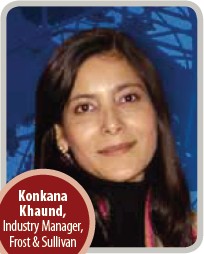Integration within buildings is not uncommon. Video surveillance is rigged so video pops up in response to opening of doors or sounding of alarms. Entrance access cards are used to call and control elevators. More and more systems are being integrated in different buildings around the world. “Two of these systems are lighting and building automation. Both are growing very quickly, according to Konkana Khaund, Industry Manager, Frost & Sullivan said. “The global building automation systems market is estimated to be in the range of US$4.5 billion to $6 billion and the global lighting market is estimated at approximately $80 billion.”
Integration within buildings is not uncommon. Video surveillance is rigged so video pops up in response to opening of doors or sounding of alarms. Entrance access cards are used to call and control elevators. More and more systems are being integrated in different buildings around the world.
“Two of these systems are lighting and building automation. Both are growing very quickly, according to Konkana Khaund, Industry Manager, Frost & Sullivan said. “The global building automation systems market is estimated to be in the range of US$4.5 billion to $6 billion and the global lighting market is estimated at approximately $80 billion.”
 In recent times, much building integration work is in retrofit buildings, said Khaund, as the global buildings market is still suffering from the effects of the recession and construction statistics are not good. There are many more constraints when working in retrofits versus working on newly constructed buildings, it is best to begin with the end in mind, said Rosario.
In recent times, much building integration work is in retrofit buildings, said Khaund, as the global buildings market is still suffering from the effects of the recession and construction statistics are not good. There are many more constraints when working in retrofits versus working on newly constructed buildings, it is best to begin with the end in mind, said Rosario.
Asian markets are even more dependent on the whims of the owner, as building codes are not as clear. “In Asia more than in other regions, the systems in a building are up to the owners.” “In Europe and North America, when constructing a new building, you know what kind of technology is going in because it is specified in codes,” said Khaund. “Many other countries are lagging because they are lacking codes written into laws. It is up to the owners and developers to take a stand on what kind of smart building they want. Some are doing it because of a status thing, not driven by wanting consume less energy.
A helpful trend emerging is more receptive attitudes by owners toward new technologies. “When a new technology appears, rather than question costs, owners are more likely to think long term gains,” said Khaund. “Building owners are currently more receptive to total cost of ownership (TCO), life cycle costing for building.”
Green & Energy Efficiency
How do energy efficiency or green initiatives cooperate and conflict with security systems?
 By integrating security systems and building management systems, this can help building systems sleep and save energy. “Access control systems can be integrated with lighting control and room temperature control,” said Vincentius Liong, Sales and Marketing Director for Adyawinsa Ademco Security.
By integrating security systems and building management systems, this can help building systems sleep and save energy. “Access control systems can be integrated with lighting control and room temperature control,” said Vincentius Liong, Sales and Marketing Director for Adyawinsa Ademco Security.
Another example Liong gave involves controlling the temperature based on the number of people in a room. “This would offer benefits such as occupant comfort (not too cold or not too warm), energy efficiency and cost saving at the bottom line,” said Liong.
However, though building management systems can be asleep at times, security systems must stay up all the time. Video surveillance systems with many servers will consume large amounts of energy. “If there's a server for every 16 cameras, and you have an installation of 100 cameras, that's six or seven servers, using a lot of energy and creating a lot of heat,” said Adam Querker, VP of Engineering, Firetech Engineered Systems. “Instead, you could use one server that accommodates up to 64 cameras.”
Mark Hayman, Associate Director of Security Resilience and Risk, Arup, reminded that if crime prevention through environmental design principles are followed from the beginning, this may reduce the amount of security equipment that is needed, including surveillance cameras.
Querker described an interesting conflict between a green initiative and life safety goals. “A heat recovery unit was used in one of our projects. There's a big shaft that goes up the building where air handlers all exhaust into that shaft, so that heat is recovered and used to heat the building. The danger is that essentially, you're causing a chimney effect. If a fire was to occur, that would be a problem.” To deal with the problem, fire smoke dampers were used to shut off access to the shaft, and on the roof, and fans were shut off.